
scrounge: /skrounj/ informal verb: to actively seek [books] from any available source
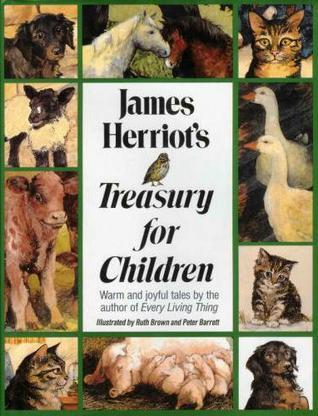
James Herriot is unparalleled when it comes to stories of domesticated animals -- whether dogs and cats in homes or various farm animals -- and his keen observations and clear love and respect for animals.
While the stories in James Herriot's Treasury for Children are fictional, all of them feel to me as if they easily could be true, and no doubt he drew heavily on his veterinary experiences in describing these unique animals and their amusing and tender escapades.
Herriot manages to capture the human-animal bond, even with farm animals, evoking compassion, joy, and sometimes sadness, without sentimentalizing or emotionally manipulating the reader.
I grew up reading "Oscar, Cat-about-Town" and "The Christmas Day Kitten," both of which are included here, and was also introduced to some new favorites, such as "Blossom Comes Home" and "Smudge, the Little Lost Lamb." The illustrations perfectly capture the animals, people, and the views of the beautiful British countryside.
Because Herriot is British and uses some words that might be unfamiliar to American children (or perhaps it's a generational thing as well), and at times can be a bit wordy, some of these stories will probably lose the interest of preschoolers. But it's worth hanging on and trying them again later, because the best animal stories are really for all ages and have no need to be written off as "for little kids."
Scrounged From: HomeschoolClassifieds.com (Sonlight Core A)
Format: Hardcover
Author: James Herriot
Illustrators: Ruth Brown, Peter Barrett
Pages: 260
Content Advisory: As noted, a few stories are a bit sad.
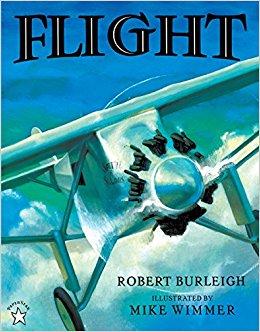
I remember reading The Spirit of St. Louis when I was high-school-aged and really enjoying it, despite its 500+ pages. Even though Lindbergh's primary topic in writing it was his historic first flight across the Atlantic Ocean, he managed to capture the monotonous moments of flight but also included enough other stories of his life that it wasn't boring.
Flight reminded me of the more dramatic and interesting parts of Lindbergh's book, since it is a narrative of that flight distilled for children. The book focuses on the long flight, bit by bit, emphasizing the difficulties, the solitude, and the length of time that Lindbergh had to stay awake in order to complete the flight. You feel like you're flying right along with him, and celebrating with him too when it's all over. The grand, expressive illustrations really aid in the drama of the story. Some children are quite fascinated by airplanes, so this particular bit of history can be very eye-opening, especially as it focuses more on the man in the cockpit rather than the machine itself.
There is no map in the book, so it might be helpful to read with one on hand if this is being used for school, since several different places are named.
Scrounged From: A local book sale
Format: Hardcover
Author: Robert Burleigh
Illustrator: Mike Wimmer
Pages: 32
Content Advisory: None
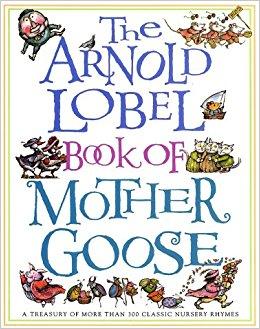
The Arnold Lobel Book of Mother Goose was an enjoyable addition to our kindergarten year. Not only do nursery rhymes build vocabulary and sometimes teach about history (not to mention cultural literacy in general), but they can also be a lot of fun, especially for the ones that have been made into songs, such as "Hey Diddle Diddle," "Three Little Kittens," "Old King Cole," etc.
There is a lot of general silliness here, and the soft, colorful illustrations by Arnold Lobel (author/illustrator of the beloved Frog and Toad series) really add to the mood on each page. Some rhymes might be a bit scary, and as is to be expected with any literature that's this old, there are references to things that might be confusing to children nowadays: death (as it was a much more common reality that children experienced around them), corporal punishment (such as references to someone being "beaten" for unacceptable behavior), and just cultural practices that seem odd to us in general, such as courtship rituals, hunting practices, and rhymes involving nobility, etc. There are also some words here that are out of general use and may need to be explained.
So some rhymes may bring up conversations with children about some of these issues, in which case it's helpful for parents/teachers to be prepared for that. But overall, we really enjoyed reading this, and my children seemed to like reading from this book even more than regular poems -- probably because there is such a variety here (and yes, my kids really enjoy silly things too), including songs. While there were quite a few rhymes here I'd never heard before, there were also many favorites that I hadn't read in a while. Sometimes wordings are slightly different from what we may be used to, but there's no rule against changing a word here and there.
This would be a good book to pair with nursery rhyme songs, such as Wee Sing Nursery Rhymes and Lullabies, so that children will occasionally hear a rhyme that is familiar to them (but not too often).
Scrounged From: HomeschoolClassifieds.com (Sonlight Core A)
Format: Hardcover
Author: Various/unknown
Illustrator: Arnold Lobel
Pages: 176
Content Advisory: As noted above, older cultural practices may be confusing for children, and there are references to corporal punishment, death, hunting, and a few somewhat mean-spirited rhymes as well.
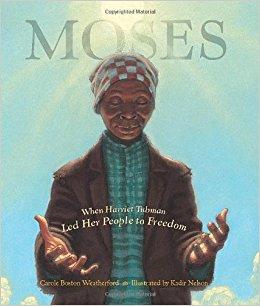
Moses: When Harriet Tubman Led Her People to Freedom is a poetic tribute to the most famous conductor on the Underground Railroad, a woman who endured the brutality of slavery and knew she had to choose between liberty and death, and so she took her freedom on her own before helping hundreds of others to do the same. This book primarily focuses on her initial escape, written in a narrative that includes an ongoing dialog between her and God, as she relies on him every step of the way.
I appreciated this perspective on her faith, even though the text does not cover many details of her life. There is an author's note at the end that gives more information about Tubman's life in slavery and her work on the Underground Railroad after her escape.
Once again, Kadir Nelson's illustrations convey so much depth of spirit here -- Harriet Tubman's courage, fear, and faith are evident in her face as well as in the text.
Scrounged From: Our local library
Format: Hardcover
Author: Carole Boston Weatherford
Illustrator: Kadir Nelson
Pages: 48
Content Advisory: The text doesn't really get into Tubman's treatment while she was enslaved, but her escape is perilous at times.
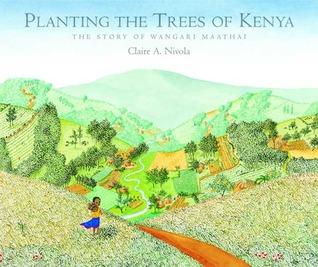
Though I just featured another picture book about Wangari Maathai (Wangari's Trees of Peace) I found Planting the Trees of Kenya to be just as wonderful at telling Wangari's story, and I also thought it was more detailed not only in the illustrations, but also in its descriptions of the before-and-after pictures of the Kenyan landscape, as well as the practical, daily benefits that a healthy amount of trees can bring to the average worker.
So not only does this story briefly cover Wangari's early life and education, but it also paints a vivid picture of her vision for re-planting the destroyed trees of Kenya, empowering the women (and men, eventually) around her to take personal responsibility for their environment, and the difference that trees can make to an environment.
This is a great story of a remarkable woman, but also a book that can help to inspire us all to take a greater sense of responsibility for the care of the land that we all live on.
Scrounged From: Our local library
Format: Hardcover
Author/Illustrator: Claire A. Nivola
Pages: 32
Content Advisory: None


